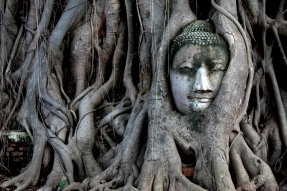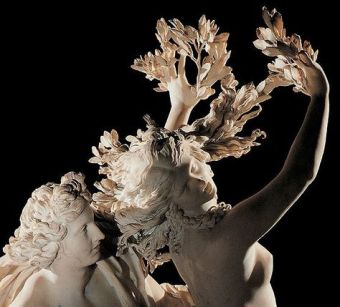by K.P. Kulski
In ancient awareness, trees have continually played an important role in symbolism across the world, through many cultures and belief systems. Some examples include the Celtic Tree of Life, the Norse Yggdrasil (symbols particularly popularized in the neo- pagan movement of modern day), the Bodhi Tree, its very name meaning the awakening or enlightenment of Buddha, and the Tree of Knowledge of the Judaic tradition. In each depiction, there are strong connections to humanity and the human experience. While the divine, or immortal may be connected to the tree, it is often in a human-like capacity that ascends into some type of enlightenment (in the case of monotheism, knowledge that leads to disaster). This can be explained by the idea that the tree is a mirror of humanity itself – ever rooted to the Earth by reaching for something greater, something higher, caught in a state in-between.
pagan movement of modern day), the Bodhi Tree, its very name meaning the awakening or enlightenment of Buddha, and the Tree of Knowledge of the Judaic tradition. In each depiction, there are strong connections to humanity and the human experience. While the divine, or immortal may be connected to the tree, it is often in a human-like capacity that ascends into some type of enlightenment (in the case of monotheism, knowledge that leads to disaster). This can be explained by the idea that the tree is a mirror of humanity itself – ever rooted to the Earth by reaching for something greater, something higher, caught in a state in-between.
As symbols of humanity, there are plenty of male and female connections to them. However, there are very specific demonstrations of female links that seem to be  repetitive in Western culture. I’d like to examine these through the lens of the Greek myth of Daphne, the nymph lustfully pursued by Apollo until she is transformed into the laurel tree in order to escape. It is a timely myth to revisit for the modern audience, as many women via the Me Too movement have spoken out against male sexual misconduct, particularly from powerful men. It has spurred not only conversations on the sexual harassment, pressure and assault on women, but questions concerning sex and power dynamics.
repetitive in Western culture. I’d like to examine these through the lens of the Greek myth of Daphne, the nymph lustfully pursued by Apollo until she is transformed into the laurel tree in order to escape. It is a timely myth to revisit for the modern audience, as many women via the Me Too movement have spoken out against male sexual misconduct, particularly from powerful men. It has spurred not only conversations on the sexual harassment, pressure and assault on women, but questions concerning sex and power dynamics.
In Greek mythology, there are plenty of stories that feature a deity and a mortal love-interest. In many cases, the female mortal or lesser immortal (such as a nymph) is unwilling, and is subsequently seduced, pressured, tricked or raped into compliance to the god’s desires. Frequently, these women become pregnant from the encounter and face tragedies or suffer greatly because of it. Because of this, it is not surprising that women would spurn interest from a god as at least an unwelcome complication, or  greater, a life-threatening or ruining possibility.
greater, a life-threatening or ruining possibility.
Daphne, faced with Apollo’s lust (which is sometimes described as love but is clearly of a purely sexual nature) rebuffs him because she has declared a life free from the complications of men in the model of the goddess Artemis. Daphne treasures her freedom and lives a life hunting and roaming free in the woods. Edith Hamilton remarks that Apollo saw Daphne in a state of physical disarray while she hunted, yet he was entranced saying, “what would she not look like properly dressed and with her hair nicely arranged?”[1]
This is a significant statement, as it alludes to “taming” something wild. The trappings of civilization, where society will ultimately insist on marriage, childbirth and domestic activities for women, are all things Daphne wishes to avoid. The pursuit of Apollo can be symbolic of the pursuit of society for women to acquiesce with societal expectations. Further, submission to male authority.
 Daphne is described as athletic and when she flees, she gives a difficult pursuit for Apollo. But he is ultimately a god, so he is able to gain ground on her. Despite Daphne’s abilities, she cannot escape Apollo’s will. We could read this as despite female abilities and potential, women cannot escape society’s will.
Daphne is described as athletic and when she flees, she gives a difficult pursuit for Apollo. But he is ultimately a god, so he is able to gain ground on her. Despite Daphne’s abilities, she cannot escape Apollo’s will. We could read this as despite female abilities and potential, women cannot escape society’s will.
Except Daphne does escape. She escapes by changing form, calling upon her father who transforms her at the last minute into a laurel tree. At this point, the myth describes Apollo’s continued “love” for her and elevation of the laurel tree in his esteem. But that glosses over the significance of Daphne’s shape-shifting as a proclamation of both the extremes women’s struggle with patriarchal cultural construction as well as a dire but possible avenue of escape. Daphne’s transformation makes her untouchable, even from men of power.
But what does that mean?
The cover of trees in both history and storytelling have provided exiles from society to

practice religions of their choosing, avoid capture and to create new lives. We might first think of Robin Hood’s Band of Merry Men. Yet it is the overtures of female mysticism that are strongly associated with the woods. In Western lore, the image of the forest dwelling witch pervades mythologies, fairytales and later religious persecution. In the latter, late medieval and early modern witch-hunts believed that women witches held ecstatic gatherings in the woods under the cover of darkness where they dedicated themselves to and engaged in sexual acts with Satan. The Maenads, the cult of Dionysius (or Bacchus in the Roman period) featured similar ecstatic and sexual forest gatherings of mostly women that often resulted in acts of violence.
The forest has often been a place of hiding, where things deemed socially unacceptable were practiced. It can offer refuge, but not without threat. The Tree of Knowledge of the Judaic tradition is forbidden, but Eden partakes unwittingly in a trade of knowledge for  the withdrawal of God’s protection. In Celtic culture, trees, or a grove can serve as a gateway to the realm of the faery, a mysterious world of amazement and entrapment, rife with equal parts wonder and danger. Such transformations and withdrawal from societal cooperation are by nature threatening to that society, but there is a freedom that can be found.
the withdrawal of God’s protection. In Celtic culture, trees, or a grove can serve as a gateway to the realm of the faery, a mysterious world of amazement and entrapment, rife with equal parts wonder and danger. Such transformations and withdrawal from societal cooperation are by nature threatening to that society, but there is a freedom that can be found.
These examples have been loud ones, stories and events that often served as subconscious warnings against the desire for liberation from patriarchal structures. Yet the mythological figure of the dryad, or other faery stories such as “La Belle Dame sans Merci,” construct a different outcome. In the case of the dryad, a female nature spirit that lives within and/or is one with a tree, the transformation and womanhood coexist. If we considered Daphne’s transformation into the laurel, akin to the existence of the dryad, then indeed, Daphne not only escaped Apollo but society itself, becoming instead a protective presence.
 I met a lady in the meads,
I met a lady in the meads,
Full beautiful – a faery’s child,
Her hair was long, her foot was light,
And her eyes were wild.[2]
John Keats describes the faery woman – la belle dame sans merci (the beautiful lady without mercy) as Apollo may have described his sighting of Daphne as she hunted. But the power structure is different, the rules of society reversed or if you will, transformed. Here the faery woman has the power.
I saw pale kings and princes too,
Pale warriors, death-pale were they all;
They cried – ‘La Belle Dame sans Merci
Thee hath in thrall!’
I saw their starved lips in the gloam,
With horrid warning gaped wide[3]
We could consider this from a negative perspective, that such a link is a sinister one, a  warning to men of what could happen if women were allowed such self-direction. Indeed it hints at the very destruction of male power structures, “…pale kings and princes too, pale warriors, death-pale were they all.”
warning to men of what could happen if women were allowed such self-direction. Indeed it hints at the very destruction of male power structures, “…pale kings and princes too, pale warriors, death-pale were they all.”
However, in its place is the woman, forced to transform in order to escape. Despite this, she has changed herself and her reality. By doing so, she has saved herself from abuse and violence, and further has claimed an unconventional power over her person, ultimately escaping patriarchal cultural requirements.
_______________________________________________________________________________________
[1] Edith Hamilton, Mythology (New York: New American Library, 1969), 115.
[2] John Keats, “La Belle Dame sans Merci: A Ballad” Poetry Foundation. Accessed 08 MAR 2018. https://www.poetryfoundation.org/poems/44475/la-belle-dame-sans-merci-a-ballad
[3] Ibid.
